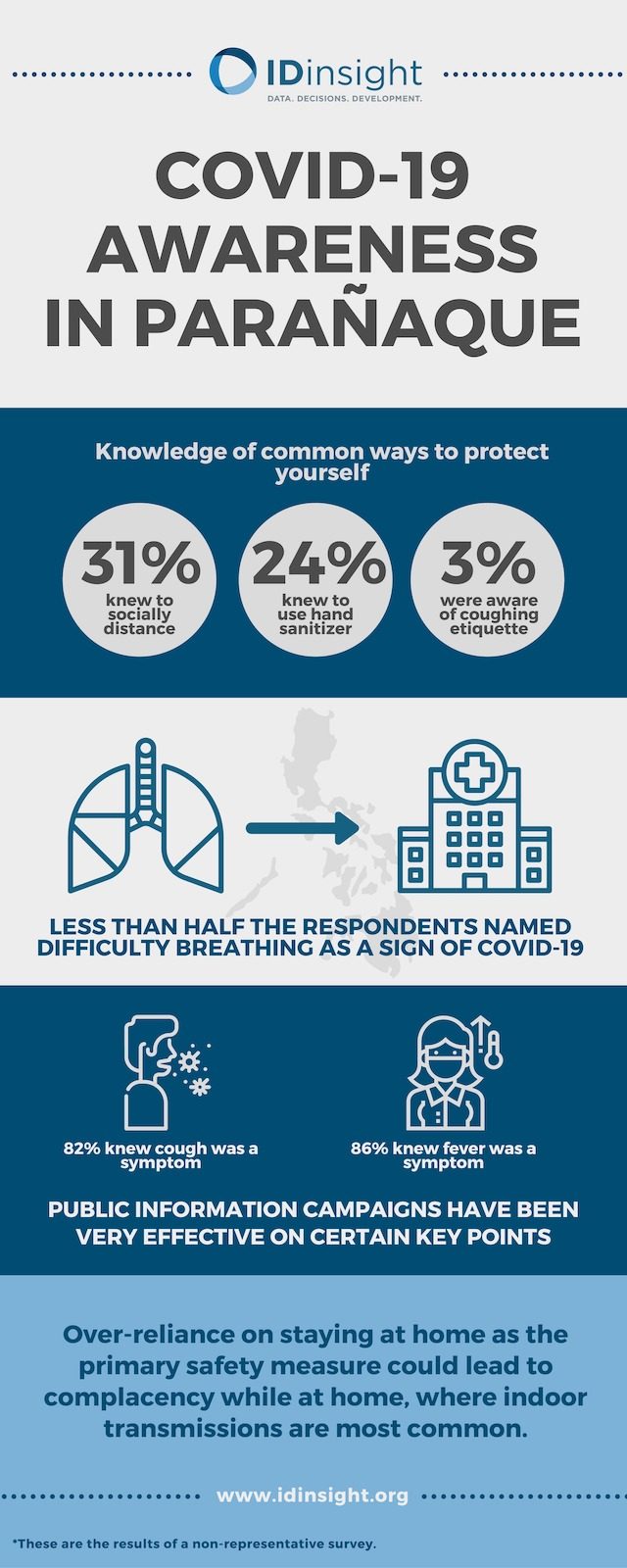SUMMARY
This is AI generated summarization, which may have errors. For context, always refer to the full article.
![[ANALYSIS] How aware are Parañaque residents about the coronavirus?](https://www.rappler.com/tachyon/r3-assets/612F469A6EA84F6BAE882D2B94A4B421/img/1767F648004A43929038E8BCBAF7C79C/covid-awareness.jpg)


The rapid spread of coronavirus and the quarantine has transformed life for nearly everyone in the Philippines, as all of us except essential workers have been forced to stay at home for over two months. As the restrictions are slowly lifted and we begin to reenter shared spaces, it is imperative that the public is equipped with the necessary information to reenter safely and respond to signs of the virus.
A recent survey conducted by our research organization, IDinsight, showed some worrying gaps in the public’s knowledge and protective practices during this pivotal time.
Our survey ran from April 29th to May 8th, in collaboration with the Parañaque City Health Department, and showed that low-income Parañaque respondents are well informed about staying home to prevent COVID-19: 92% of respondents claimed that neither they nor their family members had been in contact with anyone outside of their homes other than for essential purposes during the last week. In addition, 72% of respondents knew that staying at home was an important way to protect themselves from the virus. These findings suggest that public campaigns about staying at home to prevent transmission have been successful.
Once people start leaving their houses, however, will they know how to protect themselves from the virus? The effectiveness of the stay-at-home order tied to the Enhanced Community Quarantine may wane, as the restrictions are relaxed – people may conflate being allowed to go out of their homes with it being safe to do so. (READ: Despite GCQ, Metro Manila still far from winning COVID-19 battle)
Our findings suggest that people may not know how to protect themselves: less than half of respondents named difficulty breathing as a sign of COVID-19, a troubling finding since this symptom is the most important indicator that one should seek in-person medical care. Anyone who might have COVID-19 should be particularly on the lookout for this key symptom. The lack of knowledge when to seek treatment could lead to further loss of lives.

Further, only half knew that they should be washing their hands or wearing a mask to protect against the spread. Fewer still named social distancing, cleaning hands with sanitizer, cough etiquette, or avoiding touching one’s face as effective protection methods. These hygienic protection measures play a crucial role in stemming transmission, especially as more people come into contact with each other. In addition, overreliance on staying at home as the primary safety measure could lead to complacency while at home, where indoor transmissions are most common. When respondents were asked what they would do if a family member has mild symptoms (cough for 3 days), only 10% mentioned that they would take some measure of social distancing at home. Taking protective measures at home are important especially in intergenerational households where the elderly may share common spaces and items with working-age family members.
As people return to work and public spaces, it is essential that public health campaigns pivot to help people stay as safe as possible as they leave and return to their homes. Given the importance of hygienic practices and symptom awareness, we encourage public health officials, other media campaigns, and employers to share and reinforce these messages as much as possible. In particular, there should be widespread, intensive campaigns explaining the key symptoms of COVID-19, including clear messaging that difficulty breathing or shortness of breath requires seeking immediate medical support.
Hygienic protection measures should also be emphasized, including:
-
Maintaining 6 feet or more of physical distance in public, whenever possible, especially for those who will be in indoor public spaces.
-
Washing hands at COVID-specific critical times (in addition to after toilet use and before eating, new “moments” for hand washing include: after coughing or sneezing, when entering or leaving buildings, after physical contact with people outside, after touching high contact surfaces, after visiting public spaces, and after caring for a sick individual).
-
Avoiding directly touching surfaces and your mouth, eyes, and nose.
-
Taking protective measures inside the home or workplace, such as disinfecting and discouraging the use of shared items, especially food, plates, and utensils, and avoiding close contact with elderly or vulnerable family members.
As Dr Olga Virtusio, Parañaque’s City Health Officer said, “Our health teams have been so focused on providing life-saving care to people who are sick. But we cannot neglect the importance of the proper information and awareness among the community, especially as guidelines are changing and people are going back to work. It is essential that everyone take responsibility for protecting themselves and their families through handwashing and other hygienic measures.” (READ: ‘Premature’ to ease modified ECQ in Metro Manila – U.P. experts)
We were heartened to see that “stay at home” campaigns worked, both at changing behavior and by helping people understand why these actions were important. With the lifting of restrictions, now it’s time to modify these messages to address the biggest gaps in knowledge, and encourage behaviors that can save their lives. – Rappler.com
Meg Battle and Aya Silva lead IDinsight’s work in Southeast Asia from Manila. IDinsight is a research organization that helps social impact programs generate and use data and evidence to inform decision-making.
Add a comment
How does this make you feel?
There are no comments yet. Add your comment to start the conversation.